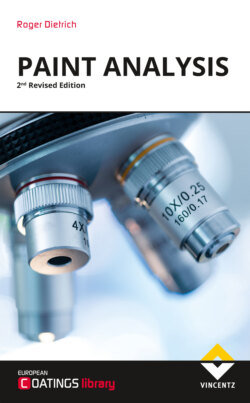Читать книгу Paint Analysis - Roger Dietrich - Страница 21
2.4Instrument selection
ОглавлениеThe following step in the analytical process is to decide which technical approach must be chosen to prove or disprove the theory. In fact, this step needs a little bit of education because you must have the background which method delivers which results and you must know the limits.
Since one single method cannot cover everything, the choice of a method will result in “losing” certain information, either consciously or unconsciously. Therefore, the question: “Was the right measurement method used to answer the question at hand?” plays a very important role. But what is “right” or “wrong”? It is clear to everyone that a hammer is the “right” tool for hammering a nail, for example. Of course, with some practice one can also hammer nails into the wall with a pipe wrench. But the fact that one masters this with virtuosity after a few years of practice still does not make the pipe wrench the “right” tool for this task. Sometimes the aspect of availability of the method plays a bigger role than the suitability of the method. According to the slogan “If you have a hammer, every problem looks like a nail”, questions are treated with methods that offer only a limited suitability for this purpose. For example, it is technically possible to examine a surface for substances that interfere with paint wetting using scanning electron microscopy (SEM), but this does not make sense because the necessary detection sensitivity is not available and organic substances cannot be identified. This means that even if one has a SEM available and handle it with virtuosity, it is not the appropriate method for the problem. The author read a few reports in the past saying, “PWIS (paint wetting impairment substances) were not detected by scanning electron microscopy". This is objectively correct, because PWIS cannot be detected with the SEM method. However, the value of this finding is of the order of “At night it is colder than outside!”. So, to illustrate what I mean, let us look at a paint crater issue. The approach “here we have a crater! Please analyse it.” will not lead to any satisfying results. You must know what can cause a paint cratering and based on this knowledge, you would want to put up the right questions and chose the appropriate methods to investigate the theory.
For the crater issue e.g., this means:
Are there lacquer wetting disturbing substances (PWIS) in the crater?
Is the enrichment of a filler or a hardener detectable?
Are foreign aerosols detectable in the crater?
These questions usually define the type and number of possible investigation procedures.
The initial analyses usually serve to confirm or disprove a theory developed based on data from the preliminary assessment and the collection of facts about the cause of the fault.
Referring to the above-mentioned example, of course, you want to have the answer to the question “what is the cause?”
But this question is not answered by an analysis. Rather, the question must be, for example:
“Are there adhesion-disturbing substances in the interface, where the delamination occurs and if so, which ones?” This is a question that can be answered unambiguously with instrumental analysis. Which shows, that a certain amount of prior knowledge about what (theoretically) can cause adhesion problems and what to look for is inevitable.
| Table II.1: Possible applications of analytical methods for paint defects | ||
| Failure type | Possible causes | Analytical tools |
| Specks | Inclusion of foreign particles | SEM/EDSIR-microscopy |
| Adhesion deficiency | wrong mixing ratio of binder and hardener component | IR (ATR, transmission) |
| separating agents | TOF-SIMS | |
| oil or grease residues | TOF-SIMS | |
| Wetting failure | oil or grease residues | TOF-SIMS |
| Paint crater, pin-hole | gel particles | SEM/EDSIR-microscopymicro-ATR |
| oil or grease residues | TOF-SIMS | |
| oily aerosols | TOF-SIMS | |
| Bubbles and blisters | outgassing of the substrate material caused by cracks or cavities | metallographic cross section + optical light microscopy and/or SEM |
| salts | SEM/EDS | |
| water | - | |
| application failure | - | |
| Stains and precipitations on coating surface | migration of additives to the surface | ATR-FT-IR |
| external contaminations | TOF-SIMS |
Once the exact question has been formulated, the selection of the appropriate measuring methods is usually based on the desired parameters like e.g. sensitivity, sample size, size of the area to be analysed etc. If, as outlined above, the possible substances that might interfere with adhesion are questioned and consider that even very small quantities of certain substances cause an adhesion deficiency, then the prerequisites for a suitable measuring method are:
very high detection sensitivity and
a high surface sensitivity and
the possibility to deliver molecular information.
This means that scanning electron microscopy, for example, is completely unsuitable for this type of problem, because, on the one hand, it is not surface sensitive enough and, on the other hand, it only provides elemental information. So, if e.g. silicon is detected on a surface with scanning electron microscopy, it is not possible to decide, whether it is adhesion inhibiting polydimethylsiloxane or non-adhesion inhibiting silicon dioxide.
